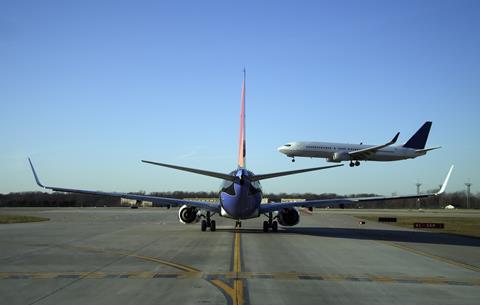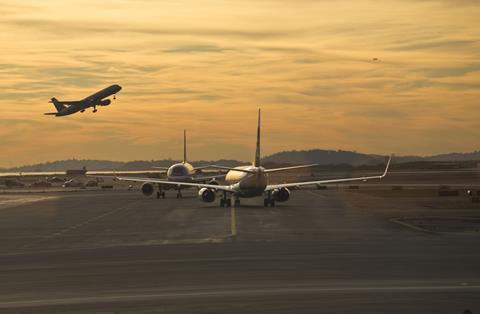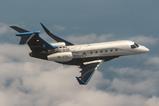Five people were killed January 2 when a jetliner with 379 passengers and crewmembers onboard collided with a coast guard aircraft on a Tokyo runway. Heroic efforts by the airliner’s cabin crew prevented greater loss of life, but the tragic accident underscores the need for immediate action to reduce the frequency of runway incursions and close calls.
Serious runway safety incidents have become entirely too commonplace at U.S. airports, leaving no doubt that Congress, the FAA and the aviation industry need to address this alarming trend.

Two airliners passed within 300 feet of each other on a Burbank, Calif., runway in February 2023, putting 118 lives at risk. A business aircraft and a jetliner came within just 100 feet of one another last summer in San Diego with 117 people onboard. And in October, two business jets collided on the runway at Houston Hobby International Airport with seven people onboard; fortunately, no one was injured.
These and more than 20 other serious runway incidents in fiscal year 2023 demonstrate that America’s approach to runway safety is insufficient and under enormous stress. The rate of serious close call incidents is rising, and these events are receiving growing attention from policymakers, the media, and the flying public.
Runway Safety Trends are Moving in the Wrong Direction
Of the nearly 55 million takeoffs and landings in fiscal year 2023, there were 23 of the most serious types of runway incursions, up from 16 in FY 2022. Human factors analysis suggests this sharp increase is not just a temporary blip in the data. It indicates a troubling trend that must be addressed immediately to prevent accidents and save lives.

In her Nov. 9 testimony before the U.S. Senate Subcommittee on Aviation Safety, Operations and Innovation, National Transportation Safety Board (NTSB) Chair Jennifer L. Homendy put it this way:
“Trends around these most serious surface incidents and other near misses are not moving in the right direction, and we must respond to these incidents seriously. Any one of these near misses could have been a devastating tragedy.”[1]
NTSB Recommends Cockpit Alerting Systems to Improve Runway Safety
NTSB Chair Homendy emphasized the vital importance of cockpit alerting systems in any effective warning system: “We continue to urge the FAA to require a system that provides direct warning capability to flight crews at all airports with scheduled passenger service, and to collaborate with aircraft and avionics manufacturers and software developers to create the technology for a cockpit system that directly alerts pilots when an airplane is not aligned with the intended runway surface.”[2]
Over the last 20 years, the FAA has installed Airport Surface Detection Equipment-Model X (ASDE-X) at 35 airports at the cost of $550 million. ASDE-X is designed to improve air traffic controllers’ awareness of potential runway surface issues, but it does not provide cockpit alerts to the pilots who play such a critical role in preventing runway incursions as the last line of defense.
Equipping an additional 470-plus airports may be cost prohibitive for American taxpayers and full deployment would likely take more than a decade while the threat of additional serious runway incursions continues.
Cockpit Alerting Technologies are Critical to Improving Runway Safety and Preventing Accidents
Onboard cockpit alerting solutions are FAA-certified, ready and available today. They can be rolled out quickly for a fraction of the cost of airport surface detection technologies such as ASDE-X and provide an enormous improvement in runway situational awareness for flight crews.
“The FAA has focused overwhelmingly on promoting technologies that equip the control tower to manage traffic on the runway surface and respond to close calls,” said Jim Currier, President and CEO for Honeywell Aerospace, a leading developer of avionics and aviation safety solutions. “This is only part of the multi-dimensional layered solutions we need to solve a safety problem of this magnitude. We also need to give flight crews highly intuitive warning systems so they can respond quickly and efficiently in an emergency and prevent catastrophe.”
Currier added, “We must work to bring ready-now safety technologies like the runway awareness and advisory system (RAAS) to the flight deck. RAAS software is already installed on most newer Boeing and Airbus aircraft, but only a few airlines are currently using the system.[3]”
RAAS is an advisory system that provides aural alerts to increase a pilot’s situational awareness during ground and air operations at the airport. Because it is a software upgrade to the enhanced ground proximity warning system (EGPWS), the RAAS is significantly more cost-effective than ground-based runway incursion solutions. As required equipment on commercial aircraft, the EGPWS has been credited with saving countless lives since its introduction in the 1970s.
Pilot Community Supports Greater Use of Cockpit Alerting Systems
Capt. Jason Ambrosi, President of the Air Line Pilots Association, International (ALPA) also testified before the Senate Subcommittee on Nov. 9. “Flight deck enhancements are important for flight crews to increase situational awareness and receive alerts early enough to take action to avoid a near miss or an accident,” he stated. “No stone should go unturned as we look to advancements in technology to help address these near miss events.”[4]
“The path forward will be challenging,” Currier concluded. “Creating a technology roadmap encompassing both airside and ground-based solutions will require strong leadership from the FAA and the active engagement of airlines and aircraft operators, original equipment manufacturers, safety solution suppliers, pilots and air traffic controllers.”
Honeywell is a leading developer of aviation safety technology including runway awareness and advisory system (RAAS) technology.
[1] NTSB Chair Homendy testimony before the U.S. Senate Subcommittee, November 9, 2023.
[2] NTSB Chair Homendy testimony before the U.S. Senate Subcommittee, November 9, 2023.
[3] Airlines, Regulators Weigh More Cockpit Safety Alerts After Close Calls on Runways - WSJ
[4] Addressing Close Calls to Improve Aviation Safety - U.S. Senate Committee on Com…





























